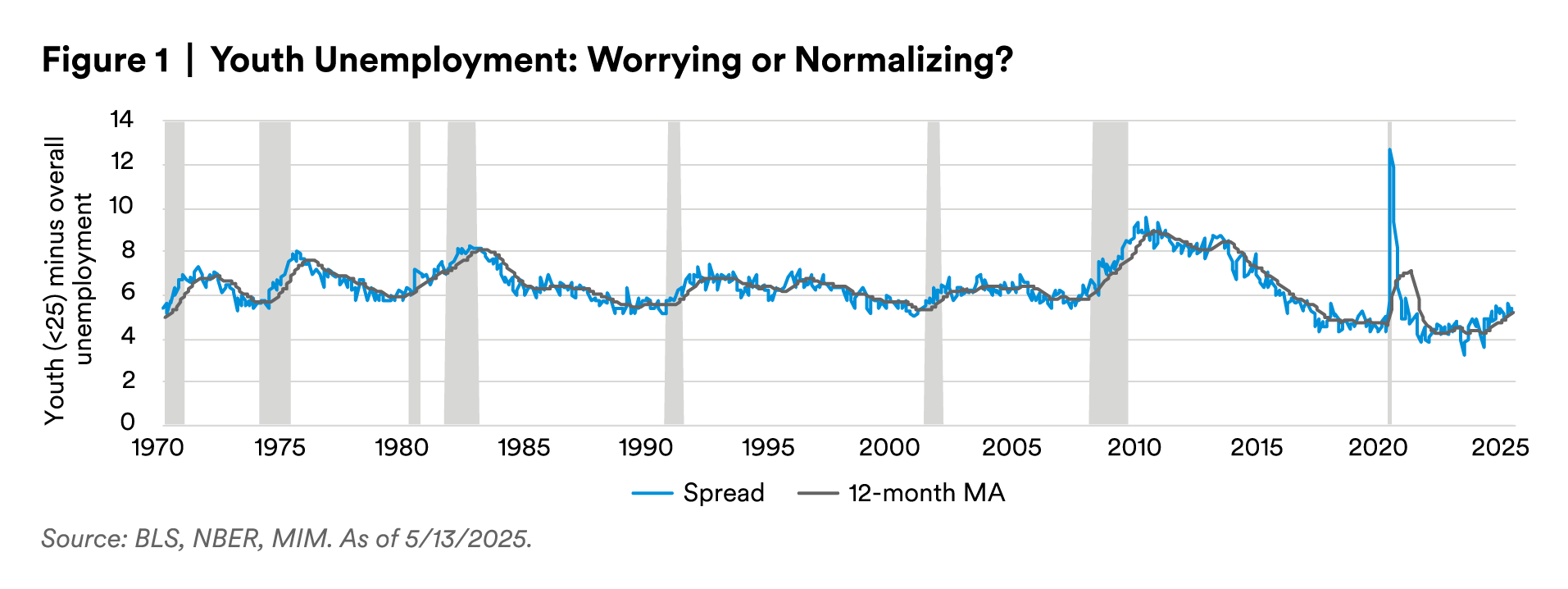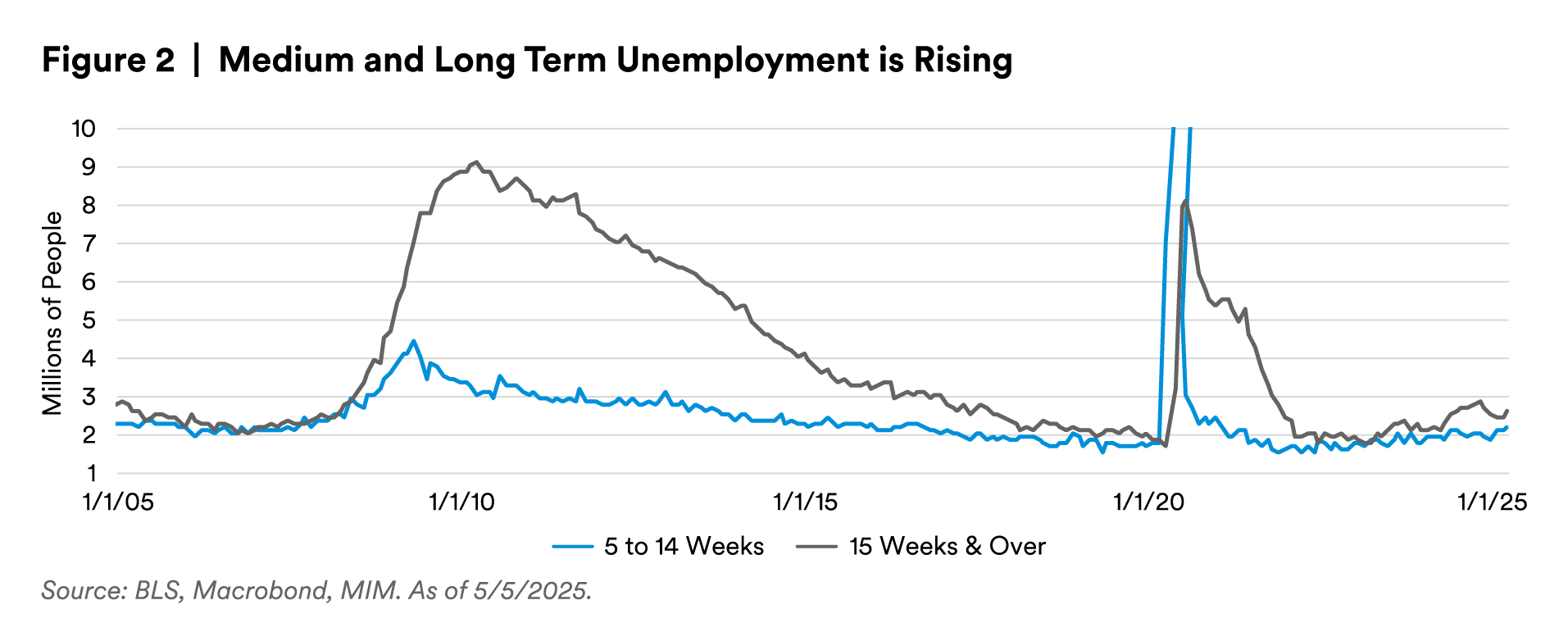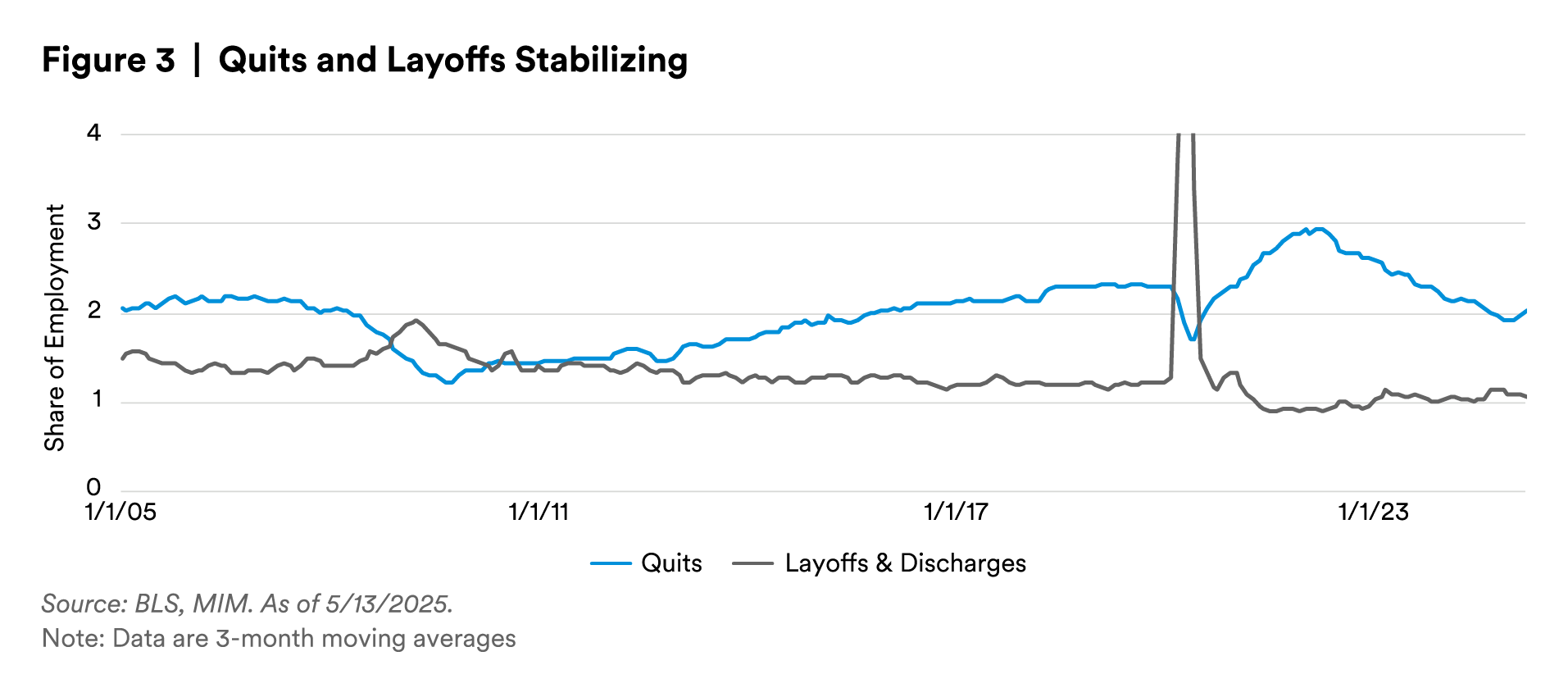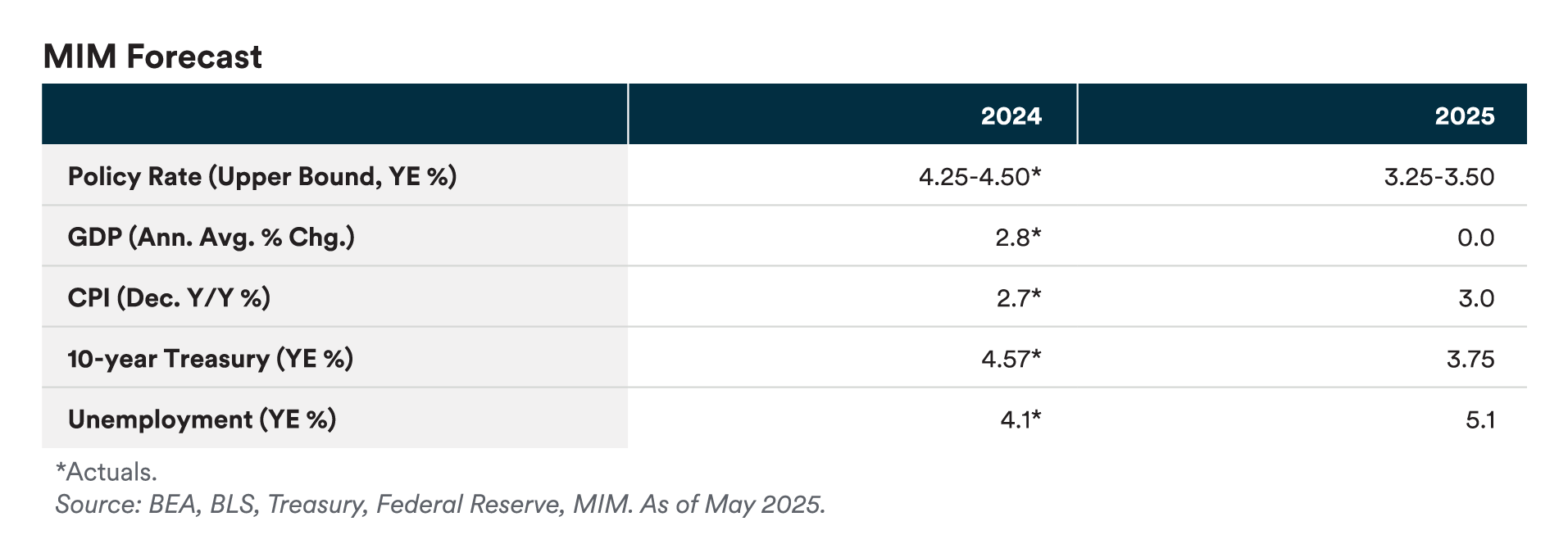Current youth unemployment rates have attracted considerable attention as young college graduates struggle to find jobs. Indeed, youth unemployment has been rising rapidly relative to the overall unemployment rate.
Historically, the widening of the gap between youth unemployment and overall unemployment has been associated with a recession. But this time could be different: the gap between the two is still quite small, relative to history, and the immigration-associated labor dynamics are still filtering through the economy.

On the first point: the 5-percentage point gap between youth and overall unemployment is historically associated with an extremely tight labor market. The current youth unemployment rate of 9.6% would have been enviable in the decade following the financial crisis, when youth unemployment averaged 14%.[1]
Immigration has been dramatically curtailed, beginning in 2024 and accelerating under President Trump. The slower flow of immigration will filter through to the stock of labor gradually but should tighten at least some parts of the labor market over time.
The number of people unemployed for five weeks or fewer continues to be stable, but we are concerned about the slow and steady rise of people unemployed for longer periods. As people enter the labor market (i.e., the labor force participation rate improves as it did in April), it appears to be increasingly difficult to actually find a job.

The latest BLS data shows that the median duration of unemployment reached 10.4 weeks in April, a length not seen since December 2021. Almost 1.7 million Americans had been unemployed for more than 27 weeks in April, a level (excluding the pandemic) that has not been seen since 2017, when the labor market was still arguably absorbing the massive unemployment shock of the 2008 financial crisis.
If companies stop hiring and pause investment decisions due to fiscal and economic uncertainty, we can expect these metrics to continue to worsen. Additionally, changes in policy may also cause structural unemployment, particularly in industries that are negatively affected by tariffs or reductions in government spending.
We see firms behaving quite cautiously in the labor market and the market may be tilting slightly in favor of workers.
Firms have remained very reluctant to lay off workers. The layoff rate has not recovered from its post-pandemic lows. There has been a very gradual increase in the share of workers being laid off since early 2022, the peak of labor market tightness.
By contrast, the quits rate has recovered from post-pandemic distortions. Workers have been increasingly reluctant to quit their jobs since 2022. Quits are now in a more ordinary range.
Since the November 2024 election, we have seen a slight tightening of the labor market. Quits have reversed their slide and hooked higher, revealing improved confidence in the labor market for workers. At the same time, layoff rates have stopped rising and remain in their post-pandemic lows.
This has happened in the context of two sets of policies implemented by the Trump Administration. First, the crackdown on immigration has likely reduced the flow of workers into the workforce, shifting the balance of power toward the now relatively scarcer workers. Second, the tariff policies have bred enormous uncertainty, which appear to have frozen firms in place as they wait for greater resolution before engaging in strategic changes.

We still expect a recession in the U.S., although the probability (60%) remains close to a coin flip. However, we are (very) cautiously optimistic, given the progress on “trade deals” and in particular in lowering tariffs on China.
Our biggest concern remains with investment. Volatile policies and valuations are causing some firms to slow investment and hiring decisions, as well as deal-making. We expect the 10% near-universal tariff rate to cut significantly into profit margins. This is likely to particularly affect smaller businesses, who have less pricing power, lack the deep pockets to accumulate inventory, and are less likely to be diversified against shocks.
Consumers are increasingly worried, according to recent survey data. In the near term, we expect households and firms to continue to front-load the purchase of imported goods, with a tapering off into midyear. We are also concerned about whether the households who are invested in the stock market will pull back spending in light of volatile markets. Households in the top 10% make up 50% of all consumption, so the behavior of this group of consumers is critical to continued economic growth.
Q2 is likely to be a critical one for the labor market, as the cumulative effects of tariffs, DOGE actions, and policy uncertainty filter into earnings and economic data.
Chair Powell, in his recent remarks, repeatedly articulated his satisfaction with the current monetary policy stance. We expect the Fed to resist cutting until there is greater clarity on the ultimate effect of tariffs on prices. In the second half of the year – assuming that tariff policy settles down by then – we expect labor market dynamics to rise in importance and the FOMC to make substantial cuts to the Fed Funds rate.
Looking forward, we expect continued tariff uncertainty as well as a broadening of attention by the Trump Administration to include more growth-oriented policies such as tax cuts and deregulation.
The risks to our view are tilted toward stronger than expected growth. Some sort of “Liberation Day” tariffs are likely to remain in place, but if there is a moderation in the universal tariffs, a détente with China, and few or no other bilateral tariffs are imposed, this could help tilt the economy toward growth. We also expect the Trump Administration to focus on more growth-positive policies in the second half of the year, including deregulation and an extension of the Tax Cuts and Jobs Act.

Labor markets may remain stronger than we expect, especially given the diverse actions that are broadly discouraging of inbound labor flows.
If an off-base case growth scenario does begin to prevail, however, we would expect it to go hand in hand with greater inflation as consumers remain relatively strong and continue to tolerate higher prices.
Endnote
1. BLS Youth unemployment 2009-2018.
Disclaimer
This material is intended solely for Institutional Investors, Qualified Investors and Professional Investors. This analysis is not intended for distribution with Retail Investors.
This document has been prepared by MetLife Investment Management (“MIM”)1 solely for informational purposes and does not constitute a recommendation regarding any investments or the provision of any investment advice, or constitute or form part of any advertisement of, offer for sale or subscription of, solicitation or invitation of any offer or recommendation to purchase or subscribe for any securities or investment advisory services. The views expressed herein are solely those of MIM and do not necessarily reflect, nor are they necessarily consistent with, the views held by, or the forecasts utilized by, the entities within the MetLife enterprise that provide insurance products, annuities and employee benefit programs. The information and opinions presented or contained in this document are provided as of the date it was written. It should be understood that subsequent developments may materially affect the information contained in this document, which none of MIM, its affiliates, advisors or representatives are under an obligation to update, revise or affirm. It is not MIM’s intention to provide, and you may not rely on this document as providing, a recommendation with respect to any particular investment strategy or investment. Affiliates of MIM may perform services for, solicit business from, hold long or short positions in, or otherwise be interested in the investments (including derivatives) of any company mentioned herein. This document may contain forward-looking statements, as well as predictions, projections and forecasts of the economy or economic trends of the markets, which are not necessarily indicative of the future. Any or all forward-looking statements, as well as those included in any other material discussed at the presentation, may turn out to be wrong.
All investments involve risks including the potential for loss of principle and past performance does not guarantee similar future results. Property is a specialist sector that may be less liquid and produce more volatile performance than an investment in other investment sectors. The value of capital and income will fluctuate as property values and rental income rise and fall. The valuation of property is generally a matter of the valuers’ opinion rather than fact. The amount raised when a property is sold may be less than the valuation. Furthermore, certain investments in mortgages, real estate or non-publicly traded securities and private debt instruments have a limited number of potential purchasers and sellers. This factor may have the effect of limiting the availability of these investments for purchase and may also limit the ability to sell such investments at their fair market value in response to changes in the economy or the financial markets.
For Investors in the U.S.: This document is communicated by MetLife Investment Management, LLC (MIM, LLC), a U.S. Securities Exchange Commission registered investment adviser. MIM, LLC is a subsidiary of MetLife, Inc. and part of MetLife Investment Management. Registration with the SEC does not imply a certain level of skill or that the SEC has endorsed the investment advisor.
For investors in the UK: This document is being distributed by MetLife Investment Management Limited (“MIML”), authorised and regulated by the UK Financial Conduct Authority (FCA reference number 623761), registered address One Angel Lane 8th Floor London EC4R 3AB United Kingdom. This document is approved by MIML as a financial promotion for distribution in the UK. This document is only intended for, and may only be distributed to, investors in the UK who qualify as a "professional client" as defined under the Markets in Financial Instruments Directive (2014/65/EU), as per the retained EU law version of the same in the UK.
For investors in the Middle East: This document is directed at and intended for institutional investors (as such term is defined in the various jurisdictions) only. The recipient of this document acknowledges that (1) no regulator or governmental authority in the Gulf Cooperation Council (“GCC”) or the Middle East has reviewed or approved this document or the substance contained within it, (2) this document is not for general circulation in the GCC or the Middle East and is provided on a confidential basis to the addressee only, (3) MetLife Investment Management is not licensed or regulated by any regulatory or governmental authority in the Middle East or the GCC, and (4) this document does not constitute or form part of any investment advice or solicitation of investment products in the GCC or Middle East or in any jurisdiction in which the provision of investment advice or any solicitation would be unlawful under the securities laws of such jurisdiction (and this document is therefore not construed as such).
For investors in Japan: This document is being distributed by MetLife Investment Management Japan, Ltd. (“MIM JAPAN”), a registered Financial Instruments Business Operator (“FIBO”) conducting Investment Advisory Business, Investment Management Business and Type II Financial Instruments Business under the registration entry “Director General of the Kanto Local Finance Bureau (Financial Instruments Business Operator) No. 2414” pursuant to the Financial Instruments and Exchange Act of Japan (“FIEA”), and a regular member of the Japan Investment Advisers Association and the Type II Financial Instruments Firms Association of Japan. In its capacity as a discretionary investment manager registered under the FIEA, MIM JAPAN provides investment management services and also sub-delegates a part of its investment management authority to other foreign investment management entities within MIM in accordance with the FIEA. This document is only being provided to investors who are general employees' pension fund based in Japan, business owners who implement defined benefit corporate pension, etc. and Qualified Institutional Investors domiciled in Japan. It is the responsibility of each prospective investor to satisfy themselves as to full compliance with the applicable laws and regulations of any relevant territory, including obtaining any requisite governmental or other consent and observing any other formality presented in such territory. As fees to be borne by investors vary depending upon circumstances such as products, services, investment period and market conditions, the total amount nor the calculation methods cannot be disclosed in advance. All investments involve risks including the potential for loss of principle and past performance does not guarantee similar future results. Investors should obtain and read the prospectus and/or document set forth in Article 37-3 of Financial Instruments and Exchange Act carefully before making the investments.
For Investors in Hong Kong S.A.R.: This document is being issued by MetLife Investments Asia Limited (“MIAL”), a part of MIM, and it has not been reviewed by the Securities and Futures Commission of Hong Kong (“SFC”). MIAL is licensed by the Securities and Futures Commission for Type 1 (dealing in securities), Type 4 (advising on securities) and Type 9 (asset management) regulated activities.
For investors in Australia: This information is distributed by MIM LLC and is intended for “wholesale clients” as defined in section 761G of the Corporations Act 2001 (Cth) (the Act). MIM LLC exempt from the requirement to hold an Australian financial services license under the Act in respect of the financial services it provides to Australian clients. MIM LLC is regulated by the SEC under US law, which is different from Australian law.
For investors in the EEA: This document is being distributed by MetLife Investment Management Europe Limited (“MIMEL”), authorised and regulated by the Central Bank of Ireland (registered number: C451684), registered address 20 on Hatch, Lower Hatch Street, Dublin 2, Ireland. This document is approved by MIMEL as marketing communications for the purposes of the EU Directive 2014/65/EU on markets in financial instruments (“MiFID II”). Where MIMEL does not have an applicable cross-border licence, this document is only intended for, and may only be distributed on request to, investors in the EEA who qualify as a “professional client” as defined under MiFID II, as implemented in the relevant EEA jurisdiction. The investment strategies described herein are directly managed by delegate investment manager affiliates of MIMEL. Unless otherwise stated, none of the authors of this article, interviewees or referenced individuals are directly contracted with MIMEL or are regulated in Ireland. Unless otherwise stated, any industry awards referenced herein relate to the awards of affiliates of MIMEL and not to awards of MIMEL.
1 As of December 31, 2024, subsidiaries of MetLife, Inc. that provide investment management services to MetLife’s general account, separate accounts and/or unaffiliated/third party investors include Metropolitan Life Insurance Company, MetLife Investment Management, LLC, MetLife Investment Management Limited, MetLife Investments Limited, MetLife Investments Asia Limited, MetLife Latin America Asesorias e Inversiones Limitada, MetLife Investment Management Japan, Ltd., MIM I LLC, MetLife Investment Management Europe Limited and Affirmative Investment Management Partners Limited.




